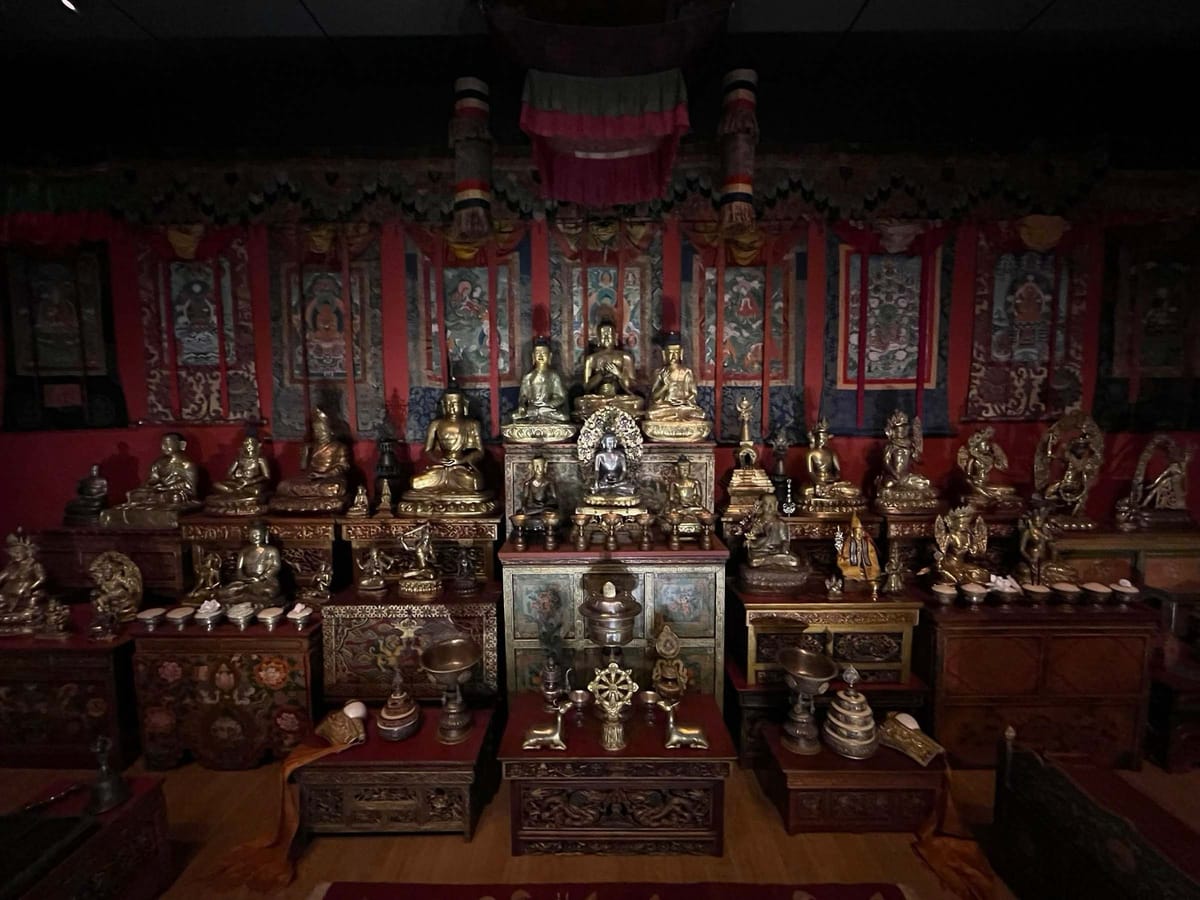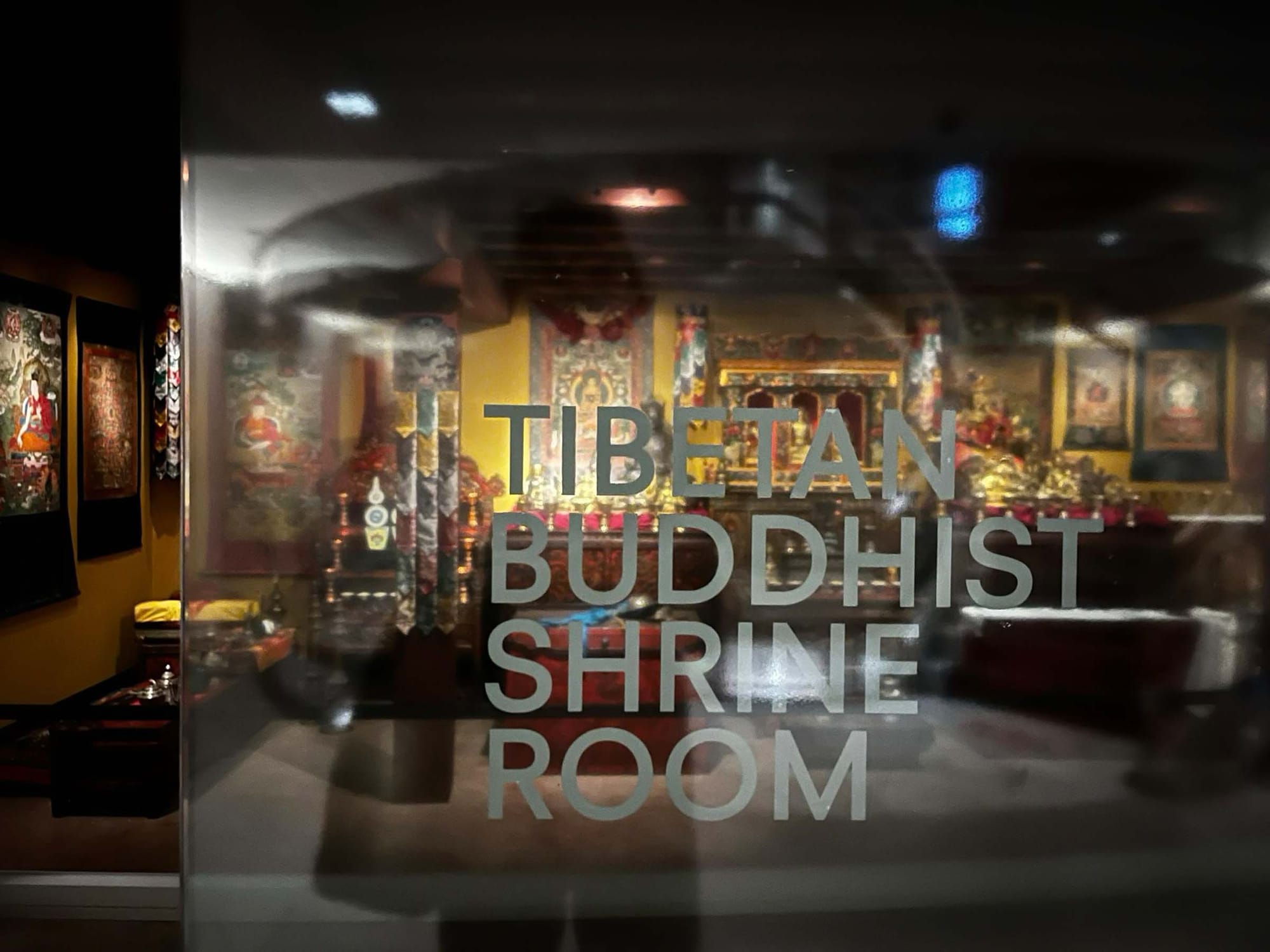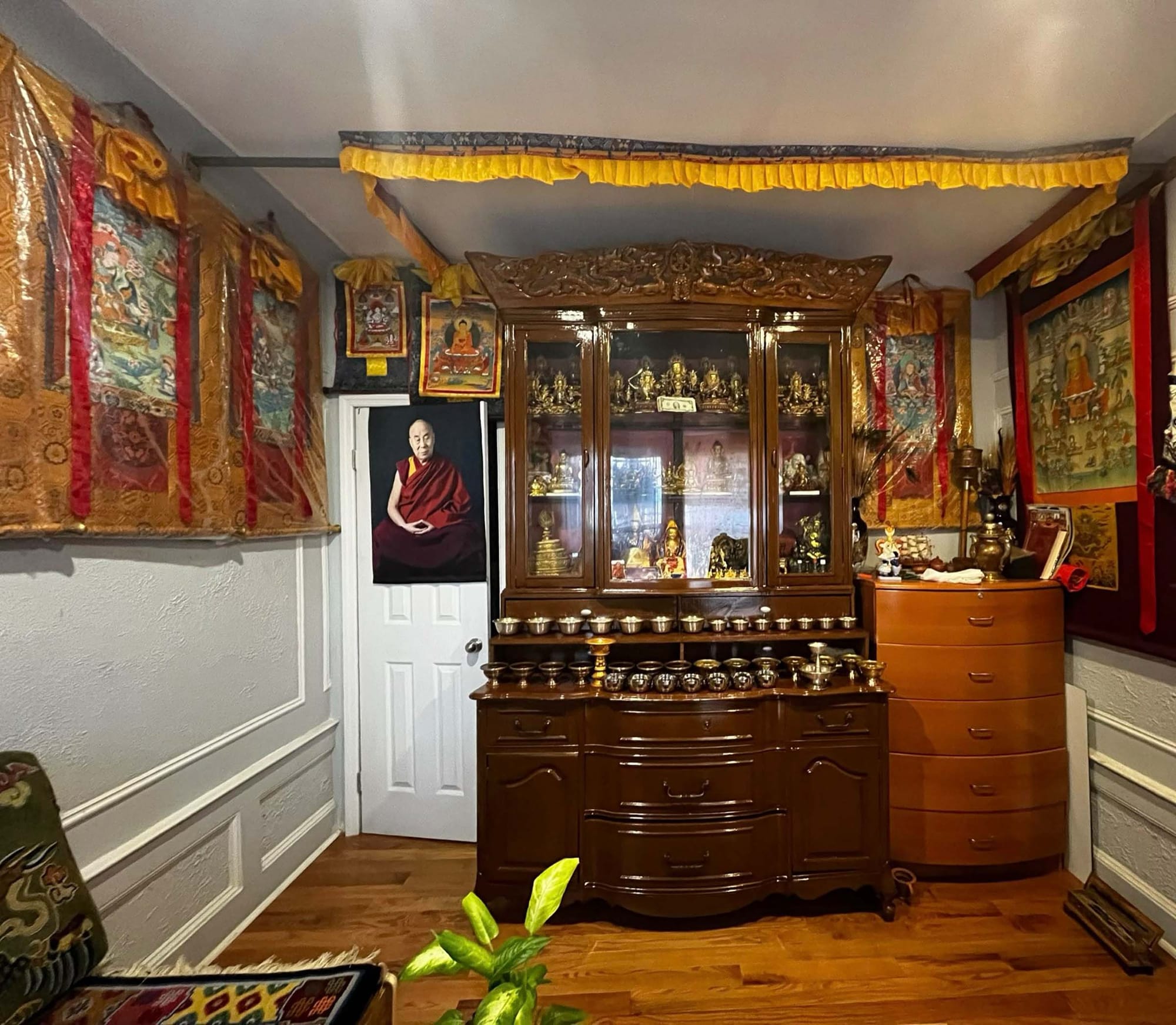The Fetishistic Fiction of Museums' “Tibetan” Shrines
Institutions peddle a Western aesthetic of “traditional” Tibetan shrines without scholarly backing, negating their limitless lived variety.

If American museums were the only source of information about Tibetan Buddhist shrines, one would come away with the impression that shrines are elaborate, pristine environments layered with thangka paintings and silken finery amidst rows of statuary and ritual objects organized atop beautifully crafted wooden furniture. Enveloped by recordings of soft Buddhist chanting and illuminated by flickering LED butter lamps, the shrine rooms of the Rubin Museum of Himalayan Art (formerly in New York and now operating without a fixed location) and the Smithsonian’s National Museum of Asian Art in Washington, DC suspend visitors in a sumptuous, carefully curated environment. To this end, curators have intentionally omitted labels or didactics within the gallery, ostensibly to preserve the viewer’s contemplative experience. Touted as “magnificent” and seen as a “refuge in uncertain times,” these immersive spaces have long captivated the public and media alike. But what if these beloved spaces, attracting thousands of visitors each year, are just sites of appropriation — of both tangible and intangible cultural heritage? In light of the Brooklyn Museum of Art’s recent opening of its six-year loan of the Rubin Museum’s Tibetan Buddhist Shrine Room, I think the question is worth reexamining.
The sensory-immersive “Tibetan Buddhist Shrine Rooms” popular in American museums since 2010 differ markedly from their predecessors of the 1930s and ’40s, when institutions such as the Newark Museum of Art in New Jersey and the Jacques Marchais Museum of Tibetan Art in Staten Island displayed modest altars featuring Tibetan Buddhist devotional objects. Collector Alice Kandell first promoted the immersive shrine experience when she gifted a collection of over 220 Tibetan Buddhist objects to the Arthur M. Sackler Gallery of the Smithsonian. In a 2013 essay in Art of Merit, Kandell writes about this gift and her collecting practices, claiming that she “wanted the shrine to be as authentic as it would have been in Tibet.” A quotation from Smithsonian curator Debra Diamond notes the restrictions that came with Kandell’s gift, such as the “long-term display of the objects within a liturgically appropriate and distinctly separate shrine room gallery” (emphasis added), which the Smithsonian obliged. In 2010, the Rubin Museum of Art (RMA) accepted a loan of Kandell’s “shrine”; in 2013, it created its own version and kept it on view until 2024. Kandell shrines have also been displayed at the Michael C. Carlos Museum at Emory University (2016) and gifted to the Minneapolis Institute of Art.

In these aforementioned displays, the “shrines” are similarly constructed, with a shared palette of dark blues and reds accented with yellow and gold. Thangkas (paintings) often hang on the central wall, and gilt metal statuary is placed along a pyramid-like organization spilling down from the intricately carved cabinetry. All examples have embroidered banners, and some have a silk baldaquin that hangs over the central area of the shrine, often with sculptures of a wheel and two deer. By regurgitating what is largely the same shrine, however, museums are both negating the limitless variations of actual shrines and peddling a Western aesthetic of a “traditional” or “authentic” Tibetan shrine that is without any scholarly or historical backing.
For example, in January 2025, SmartHistory released an episode misleadingly titled “Tibetan Buddhist Shrine Room," which in fact only documents the RMA’s installation. As Elena Pakhoutova, curator of the RMA’s “shrine room” explains, the display is a “curated installation that presented the objects how they may have been displayed and used in a traditional Tibetan Buddhist household.” Museum installations lean problematically on the language of “tradition” and “authenticity” without scholarly backing for these claims. One is left asking: What time periods and regions inform these museum constructions? As it stands, the installations are largely ahistorical, apart from the fact that the individual objects themselves are well dated and researched. This is precisely the problem: Such curated constructions function more as a vehicle for displaying a collection than as documentation of actual shrines. Without knowledge of the lived ritual practices and historic moments that give rise to shrine environs, and without historical, ethnographic, or archival evidence to ground claims, these museum reconstructions largely remain unfounded fabrications.


From fieldwork in Tibet, the western Himalaya, and diasporic communities in Queens, New York, and Philadelphia, Pennsylvania, I have seen that a home shrine’s constellation of objects is created over generations through an array of practices related, but not limited, to liturgical need, ritual practice, and gift-giving exchanges. A functioning shrine reflects a network of reciprocity, reifying relationships and connections across space and time. One shrine in Philadelphia, owned by a Tibetan gentleman in his 70s, holds family heirlooms his parents carried out of Tibet in 1959. They brought a butter lamp and a metal sculpture of Akshobya with them on the journey to India, and eventually to the United States. For the steward, this shrine and his objects are deeply meaningful. As he said during an interview with me in 2024, “Altars, you know, they bring memory and love.” In Queens, another home shrine belongs to a Tibetan couple now in their late 60s. Since they moved to the US in 2008, they have continuously built their shrine piece by piece. They showed me their recent acquisitions of a sculpture and thangka, which are intended for their eventual death rituals. Indeed, shrines have the potential to connect powerfully to a family’s history and ancestors, and their creation and maintenance are tied to a deep sense of cosmological order.
Objects within typical shrines encompass a range of materiality: sculptures, paintings, photographs, ritual objects, and manuscripts, as well as items that might not be considered “art” by Western standards but hold deep power within Tibetan Buddhist contexts — precious pills, soil from pilgrimage sites, posters and plastic statuary, and blessed barley seeds, among others. As one steward of a centuries-old home shrine in Ladakh, India explained to me in an interview in 2005, having these objects is not what is important. Rather, as I wrote in Artful Beneficence: Selections from the David R. Nalin Himalayan Art Collection (2019), “It is the religious commitment to the images that is most important in order to keep them alive and functioning and to gain merit.” At their most basic, shrines are kept alive through prayer, prostration, puja, and by offerings of water, incense, and light. It is important to remember, however, that beyond these visible traces, invisible threads of stories and memories connect a shrine’s objects to communal history, sacred geography, and ritual practice. Even from half a world away, these objects and practices enable diasporic communities to maintain a living connection to their cultural traditions across generations.

Museum reconstructions of shrine rooms can often reduce and flatten the dynamic, varied realities of living Tibetan Buddhist shrines. Some readers might object that my critique is unfair — that I am measuring premodern-inspired museum displays against the vibrancy of contemporary shrines. But let’s be clear: The museum shrine room itself is a contemporary fabrication, built on ahistorical assumptions about what a “traditional” household shrine might have looked like. And it works. As Diamond observes in the aforementioned essay, more than 300,000 people visited their shrine in fewer than four months, and the RMA claims that their shrine room was its most popular exhibition, “experienced by more than one million visitors from the year it opened.”
In their drive to attract crowds, museums focus on creating theater-like experiences that underinform the public and further reveal far more about the Western fantasy of “elaborate private household shrines” than about the shrines themselves. What happens, then, when audiences seek more than fiction and fetish? I urge institutions like the Brooklyn Museum to interrogate and critically rethink outdated “shrine rooms” and their old curatorial underpinnings. In doing so, museums might transform these installations from static backdrops into sites of dialogue, ethical reflection, and cultural recognition.



Editor's Note, 9/15/25 10:40am EDT: A previous version of this article stated that the Brooklyn Museum's Tibetan Buddhist Shrine Room, loaned from the Rubin Museum of Himalayan Art, does not include didactics. We updated the piece to reflect that there are no didactics within the gallery itself, though there is a digital interactive screen outside of the room and online. The article also refers to the "former Rubin Museum in New York." While the institution no longer has a physical space, it is still active in advancing scholarship, collection sharing, and other initiatives. We have updated this wording for clarity.





